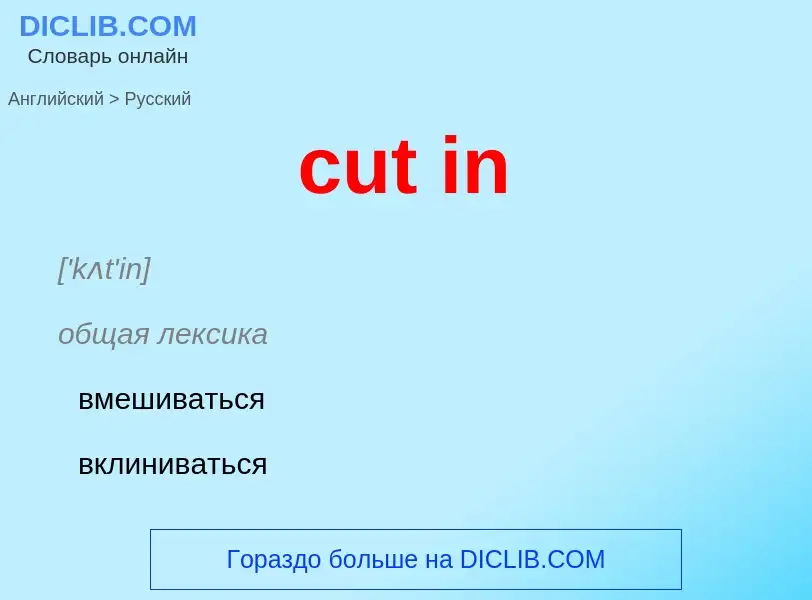Translation and analysis of words by ChatGPT artificial intelligence
On this page you can get a detailed analysis of a word or phrase, produced by the best artificial intelligence technology to date:
- how the word is used
- frequency of use
- it is used more often in oral or written speech
- word translation options
- usage examples (several phrases with translation)
- etymology
cut in - translation to russian
['kʌt'in]
общая лексика
вмешиваться
вклиниваться
электротехника
включать
электроника
врубать
фразовый глагол
общая лексика
вмешиваться (в разговор и т. п.)
прерывать
подслушивать по телефону
вклиниваться между машинами
стараться прорваться сквозь пробку
затор уличного движения
включать (в карточную игру, дело и т. п.)
включаться (в карточную игру, дело и т. п.)
предоставлять слово
отнять партнёршу на танцах
сделать резкий
крутой поворот (во время бега)
техника
включать
присоединять
кулинария
добавлять (что-л.)
осторожно перемешивая
Definition
Wikipedia
Rock-cut tombs were a form of burial and interment chamber used in ancient Israel. Cut into the landscapes surrounding ancient Judean cities, their design ranges from single chambered, with simple square or rectangular layouts, to multi-chambered with more complex designs. Almost all burial chambers contain a platform for primary burial and an ossuary or other receptacle for secondary burial. There is debate on if these tombs were originally intended for secondary burials, or if that practice arose later.
The use of rock-cut cave tombs in the region began in the early Canaanite period, from 3100–2900 BCE. The custom lapsed a millennium, however, before re-emerging in the earliest Israelite tombs, dating to the 9th century BCE in Jerusalem. The use of rock-cut tombs reached its peak in the 7th and 8th centuries BCE, before rapidly declining and eventually falling out of use in the 6th century BCE in some regions.
Use of the tombs has been recorded as recently as the late Roman period around the 3rd century CE.
The use of such tombs was generally reserved for the middle- and upper-classes, and each typically belonged to a single nuclear or extended family.


![[[Tombs of the Sanhedrin]] [[Tombs of the Sanhedrin]]](https://commons.wikimedia.org/wiki/Special:FilePath/Sanhedrin tombs 2.jpg?width=200)
![The "Tombs of the Kings"]], believed to be the tomb of [[Queen Helene of Adiabene]]; 19th-century lithograph by [[William Henry Bartlett]] The "Tombs of the Kings"]], believed to be the tomb of [[Queen Helene of Adiabene]]; 19th-century lithograph by [[William Henry Bartlett]]](https://commons.wikimedia.org/wiki/Special:FilePath/Tomb of the Kings.jpg?width=200)
![Rock-cut tomb at [[Khirbet Kurkush]] Rock-cut tomb at [[Khirbet Kurkush]]](https://commons.wikimedia.org/wiki/Special:FilePath/Khirbat-Kurkush-66.jpg?width=200)
![Mokata 'Abud]] Mokata 'Abud]]](https://commons.wikimedia.org/wiki/Special:FilePath/Abud-125916.jpg?width=200)
![Deir ed-Derb, [[Qarawat Bani Hassan]] Deir ed-Derb, [[Qarawat Bani Hassan]]](https://commons.wikimedia.org/wiki/Special:FilePath/Qarawat-Bani-Hassan-Deir-ad-Derb-094803.jpg?width=200)
